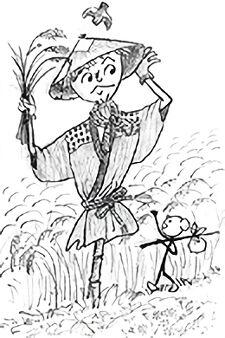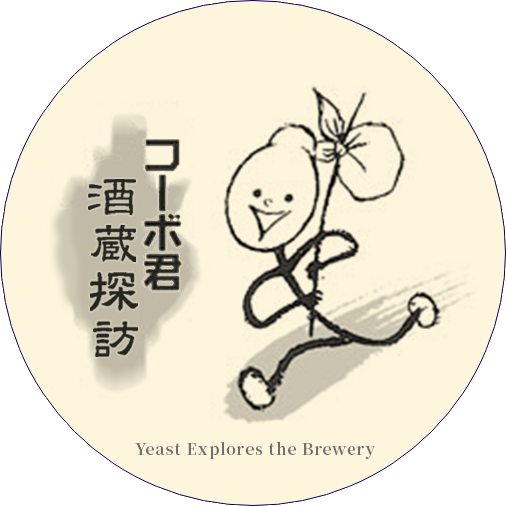| Yeast |
“This is the Mutenden field where we are all cultivating rice. Didn’t Old Well tell me that the conditions for growing good rice are large temperature differences between day and night, and the occurrence of thunder storms? Hey, who’s that?” |
| ? |
“That…!” |
| Yeast |
“Oh, I'm so surprised. Who are you?” |
| Scarecrow |
“Don’t make such an amazed face, Yeast. It’s me, Scarecrow.” |
| Yeast |
“Ah, Scarecrow. You’re doing a great job.” |
| Scarecrow |
“Did you know that when the nutrition in the soil takes the form of active ions, it is absorbed by the roots of plants?” |
| Yeast |
“You’re quite well-informed.” |
| Scarecrow |
“I’m an old acquaintance of the soil, and always anxious to improve my understanding.” |
|
 |
| Yeast |
“Please teach me!.” |
| Scarecrow |
“Alright. Ions have positive or negative electricity. When the soil is fertile, it is charged with electricity and therefore it is easy to be struck by lightning.” |
| Yeast |
“I see. There is a scientific basis.” |
| Scarecrow |
“When the temperature differences between day and night are large, the structure in the center of the ripe grains becomes rough and soft. That is called ‘white heart’ (shinpaku). You won’t find it in the rice we normally eat, but in sake rice it is a very important element.” |
| Yeast |
“Therefore I’m a bit worried. This year’s crop situation index is rather bad. Does that mean the quality of the rice won’t be very good as well?” |
| Scarecrow |
“The term ‘crop situation index’ leads to various misunderstandings. It only refers to the volume of the harvest. It happens that, although the harvest is large, the individual grains are bad in quality, or although the harvest is small, those individual grains have ripened well. Cool weather damage can have various effects, depending on whether it was cold in early summer when the rice ears were coming out, or whether there was a lot of rain at the time of pollination, or whether there was little sun in autumn when the grains were ripening. It is true that the price goes up when the volume of the harvest is small, but what counts for Daishichi is the quality of every single grain!” |
| Yeast |
“So a bad harvest does not automatically mean that the sake will be bad as well?” |
| Scarecrow |
“Exactly. It goes even so far that there is a saying among sake brewers: ‘in a year of bad harvest, there is no spoilage of the fermentation mash.’ In other words, with rice from a year of a bad harvest that has not had too much nutrition, it is easier to brew sake without worry about spoilage. Of course, good quality rice from a year with a bumper crop is best of all.” |
| Yeast |
“I understand. You do a great job. We also have to work harder!” |
| Scarecrow |
“Take it easy. Please don’t add fertilizer after the rice ears have ripened. There is a right time for doing this, and it’s wrong to give too much nutrition. If it’s done correctly, the result will be good sake with little off-flavors because of proteins, etc. In order to protect the quality, it’s important not to be greedy after a big crop.” |
| Yeast |
“I’m sorry. What’s this for brand of rice?” |
| Scarecrow |
“It’s the special sake rice called ‘Gohyakumangoku.’ The grains are large and there are only few components that can lead to off-flavors such as proteins. And in the center of the grain sits a good white heart. Gohyakumangoku is much more difficult to grow than ordinary rice, but it has always been considered as excellent rice for sake brewing.” |
| Yeast |
“What is the difference between special sake rice and ordinary rice? Isn’t it enough to polish the rice well?” |
| Scarecrow |
“Good rice is not only a matter of having few off-flavors, but rather of umami, which defines the character of the sake. The difference becomes even more obvious after maturation of the sake.” |
| Yeast |
“The importance of the rice in sake brewing is now clear to me. Hey, the young employees of Daishichi are coming.” |
| Scarecrow |
“Yes, after checking the rice plants they busily harvest them and then hang them on racks to dry. Do your best!” |
| Employees of Daishichi |
“We thoroughly study about rice in order to grasp its character, and use that knowledge when in winter we brew the sake. We have called this field Mutenden, ‘the sky is not the limit,’ because there is no limit to sake brewing. Let’s get to work!” |





